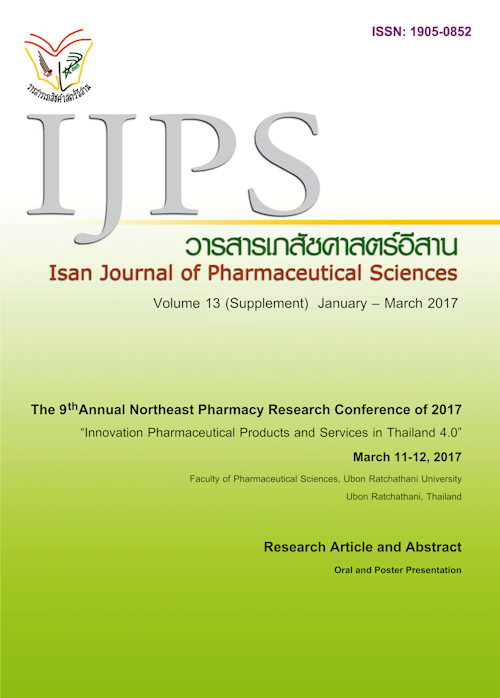Pharmaceutical care situation in community hospitals of Surin province
Main Article Content
Abstract
Introduction: Pharmaceutical care has been developing for better patient outcome. This research aimed to survey pharmaceutical care activities in community hospitals of Surin province. Methods: The questionnaire was developed based on standards of the Healthcare Accreditation Institute, criteria of the National Health Security Office and the Ministry of Public Health and literature review. The questionnaire was evaluated for content validity by experts and it was tested in 10 pilot hospitals which were not the study hospitals. Then, the questionnaire was sent to the head of the pharmacy department in 16 community hospitals, Surin province. Data were collected during October 2014 to September 2015. Descriptive statistics were used for data analysis. Results: Input evaluation revealed that 11 hospitals (68.8%) had problem of manpower shortage. Proportion of time that pharmacists could spend on conducting pharmaceutical care was less than 20% of their working time. Process evaluation found that pharmaceutical care was set as part of chronic care clinic, outpatient services. Pharmaceutical care for diabetes and hypertension were available in all 16 hospitals while the services for asthma, chronic obstructive pulmonary disease, tuberculosis, human immunodeficiency virus, psychiatric clinics were available in 12 hospitals. Pharmaceutical care for patients receiving warfarin and patients with chronic kidney disease were available in 7 and 8 hospitals. For in-patient services, 9 hospitals (56.3%) had pharmacists responsible for daily services by which medication reconciliation was the major activity. In terms of output evaluation, only some hospitals collected their output data. Coverage of pharmaceutical care provision among the new cases of diabetes mellitus, hypertension, psychiatric patients who received outpatient services was in unsatisfactory level (64-81% of all new cases). Problems of coverage of pharmaceutical care provision were also found in the in-patient services. Only 49.8% of the admitted patients received medication reconciliation service while 8.5% of them received discharge counseling service from pharmacists. Conclusion: Manpower is required for expanding pharmaceutical care activities. Currently, pharmaceutical care provision in community hospitals is increasing, however, there is problems in terms of coverage rate and data management system.
Article Details
In the case that some parts are used by others The author must Confirm that obtaining permission to use some of the original authors. And must attach evidence That the permission has been included
References
Hepler CD, Strand LM. Opportunities and responsibilities in pharmaceutical care. AJHP 1990; 47(3): 533-43.
International Statistical Classification of Diseases and Related Health Problems 10th Revision [Online]. 2010 [cited 2016 Jul 11] Available form:, edinfo.psu.ac.th/pr/pr2012/ICD/ICD10_2010.pdf
Luisetto M. European Society of Clinical Pharmacy. WHAT IS CLINICAL PHARMACY? [Online]. 2011. [cited 2015 Dec 6] Available form: http://www.escpweb.org/cms/clinical_pharmacy
Ngorsuraches S, Singhpaiboonporn N, Sornlertlumvanich A, Nima U. Songkhla Drug System. 2004. Sponsored by Health Service Research Institute.
Ningthaisong T. The pace of new pharmaceutical care to become a pharmacist, family[Online]. [cited 2016 Jun 10] Available form: http://thaihp.org/download.php?option=showfile&file=251
Ratanachodpanich T. Limwattananon S, Limwattananon C, Pitaknitinun K. Monitoring of Practice and Volume of Pharmacy Services in District Hospitals. TJHP 2008; 18(3): 265-77.
The Institute of Hospital Quality Improvement & Accreditation. Hospital and Health Care Standard Sixtieth Anniversary Cerebrations of His Majesty’s Accession to the Throne. 2015; 56-61


